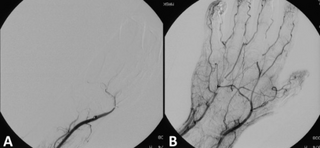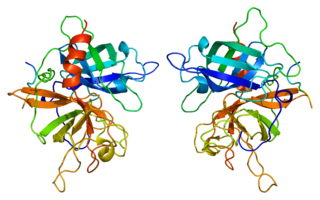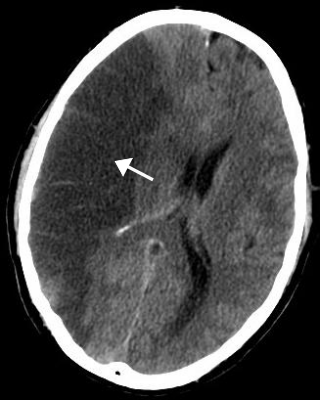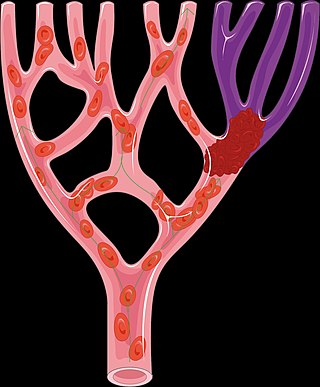Related Research Articles
A transient ischemic attack (TIA), commonly known as a mini-stroke, is a minor stroke whose noticeable symptoms usually end in less than an hour. TIA causes the same symptoms associated with strokes, such as weakness or numbness on one side of the body, sudden dimming or loss of vision, difficulty speaking or understanding language, slurred speech, or confusion.

Cerebrovascular disease includes a variety of medical conditions that affect the blood vessels of the brain and the cerebral circulation. Arteries supplying oxygen and nutrients to the brain are often damaged or deformed in these disorders. The most common presentation of cerebrovascular disease is an ischemic stroke or mini-stroke and sometimes a hemorrhagic stroke. Hypertension is the most important contributing risk factor for stroke and cerebrovascular diseases as it can change the structure of blood vessels and result in atherosclerosis. Atherosclerosis narrows blood vessels in the brain, resulting in decreased cerebral perfusion. Other risk factors that contribute to stroke include smoking and diabetes. Narrowed cerebral arteries can lead to ischemic stroke, but continually elevated blood pressure can also cause tearing of vessels, leading to a hemorrhagic stroke.

Cerebral edema is excess accumulation of fluid (edema) in the intracellular or extracellular spaces of the brain. This typically causes impaired nerve function, increased pressure within the skull, and can eventually lead to direct compression of brain tissue and blood vessels. Symptoms vary based on the location and extent of edema and generally include headaches, nausea, vomiting, seizures, drowsiness, visual disturbances, dizziness, and in severe cases, death.

Ischemia or ischaemia is a restriction in blood supply to any tissue, muscle group, or organ of the body, causing a shortage of oxygen that is needed for cellular metabolism. Ischemia is generally caused by problems with blood vessels, with resultant damage to or dysfunction of tissue i.e. hypoxia and microvascular dysfunction. It also implies local hypoxia in a part of a body resulting from constriction.

Thrombolysis, also called fibrinolytic therapy, is the breakdown (lysis) of blood clots formed in blood vessels, using medication. It is used in ST elevation myocardial infarction, stroke, and in cases of severe venous thromboembolism.

Tissue-type plasminogen activator, short name tPA, is a protein that facilitates the breakdown of blood clots. It acts as an enzyme to convert plasminogen into its active form plasmin, the major enzyme responsible for clot breakdown. It is a serine protease found on endothelial cells lining the blood vessels. Human tPA is encoded by the PLAT gene, and has a molecular weight of ~70 kDa in the single-chain form.

Stroke is a medical condition in which poor blood flow to the brain causes cell death. There are two main types of stroke: ischemic, due to lack of blood flow, and hemorrhagic, due to bleeding. Both cause parts of the brain to stop functioning properly.

Atrial septal defect (ASD) is a congenital heart defect in which blood flows between the atria of the heart. Some flow is a normal condition both pre-birth and immediately post-birth via the foramen ovale; however, when this does not naturally close after birth it is referred to as a patent (open) foramen ovale (PFO). It is common in patients with a congenital atrial septal aneurysm (ASA).
Mechanical thrombectomy, or simply thrombectomy, is the removal of a blood clot (thrombus) from a blood vessel, often and especially endovascularly as an interventional radiology procedure called endovascular thrombectomy (EVT). It thus contrasts with thrombolysis by thrombolytic medications, as either alternative or complement thereto. It is commonly performed in the cerebral arteries as treatment to reverse the ischemia in some ischemic strokes. Open vascular surgery versions of thrombectomy also exist. The effectiveness of thrombectomy for strokes was confirmed in several randomised clinical trials conducted at various medical centers throughout the United States, as reported in a seminal multistudy report in 2015.

Alteplase, sold under the brand name Activase among others, is a biosynthetic form of human tissue-type plasminogen activator (t-PA). It is a thrombolytic medication used to treat acute ischemic stroke, acute ST-elevation myocardial infarction, pulmonary embolism associated with low blood pressure, and blocked central venous catheter. It is given by injection into a vein or artery. Alteplase is the same as the normal human plasminogen activator produced in vascular endothelial cells and is synthesized via recombinant DNA technology in Chinese hamster ovary cells (CHO). Alteplase causes the breakdown of a clot by inducing fibrinolysis.

Carotid artery stenosis is a narrowing or constriction of any part of the carotid arteries, usually caused by atherosclerosis.

Intracerebral hemorrhage (ICH), also known as hemorrhagic stroke, is a sudden bleeding into the tissues of the brain, into its ventricles, or into both. An ICH is a type of bleeding within the skull and one kind of stroke. Symptoms can vary dramatically depending on the severity, acuity, and location (anatomically) but can include headache, one-sided weakness, numbness, tingling, or paralysis, speech problems, vision or hearing problems, memory loss, attention problems, coordination problems, balance problems, dizziness or lightheadedness or vertigo, nausea/vomiting, seizures, decreased level of consciousness or total loss of consciousness, neck stiffness, and fever.

Cerebral infarction, also known as an ischemic stroke, is the pathologic process that results in an area of necrotic tissue in the brain. In mid to high income countries, a stroke is the main reason for disabilty among people and the 2nd cause of death. It is caused by disrupted blood supply (ischemia) and restricted oxygen supply (hypoxia). This is most commonly due to a thrombotic occlusion, or an embolic occlusion of major vessels which leads to a cerebral infarct. In response to ischemia, the brain degenerates by the process of liquefactive necrosis.

Carotid artery dissection is a separation of the layers of the artery wall in the carotid arteries supplying oxygen-bearing blood to the head. It is the most common cause of stroke in younger adults. The term 'cervical artery dissection' should also be considered in the context of this article.

The leptomeningeal collateral circulation is a network of small blood vessels in the brain that connects branches of the middle, anterior and posterior cerebral arteries, with variation in its precise anatomy between individuals. During a stroke, leptomeningeal collateral vessels allow limited blood flow when other, larger blood vessels provide inadequate blood supply to a part of the brain.
Interventional neuroradiology (INR) also known as neurointerventional surgery (NIS), endovascular therapy (EVT), endovascular neurosurgery, and interventional neurology is a medical subspecialty of neurosurgery, neuroradiology, intervention radiology and neurology specializing in minimally invasive image-based technologies and procedures used in diagnosis and treatment of diseases of the head, neck, and spine.
Remote ischemic conditioning (RIC) is an experimental medical procedure that aims to reduce the severity of ischaemic injury to an organ such as the heart or the brain, most commonly in the situation of a heart attack or a stroke, or during procedures such as heart surgery when the heart may temporary suffer ischaemia during the operation, by triggering the body's natural protection against tissue injury. Although noted to have some benefits in experimental models in animals, this is still an experimental procedure in humans and initial evidence from small studies have not been replicated in larger clinical trials. Successive clinical trials have failed to identify evidence supporting a protective role in humans.
Elad I. Levy is an American neurosurgeon, researcher, and innovator who played a major role in the development and testing of thrombectomy, which improved quality of life and survival of stroke patients. He has focused his career and research on developing evidence based medicine and literature showing the benefits of thrombectomy for the treatment of stroke. He is currently Professor of Neurosurgery and Radiology, and the L. Nelson Hopkins, MD Professor Endowed Chair of the Department of Neurosurgery at the State University of New York at Buffalo (SUNY).
A migrainous infarction is a rare type of ischaemic stroke which occurs in correspondence with migraine aura symptoms. Symptoms include headaches, visual disturbances, strange sensations and dysphasia, all of which gradually worsen causing neurological changes which ultimately increase the risk of an ischaemic stroke. Typically, women under the age of 45 who experience migraine with aura (MA) are at the greatest risk for developing migrainous infarction, especially when combined with smoking and use of oral contraceptives.
A cerebroprotectant is a drug that is intended to protect the brain after the onset of acute ischemic stroke. As stroke is the second largest cause of death worldwide and a leading cause of adult disability, over 150 drugs tested in clinical trials to provide cerebroprotection.
References
- ↑ "Jeffrey Saver | UCLA Profiles". profiles.ucla.edu. Retrieved 2024-03-15.
- ↑ "Jeffrey Saver, MD". WebMD. Retrieved 2024-03-15.
- ↑ "Jeffrey L. Saver - Advisor at Astrocyte Pharmaceuticals". THE ORG. Retrieved 2024-03-15.
- ↑ "Jeffrey L. Saver, MD - Vascular Neurology". www.uclahealth.org. Retrieved 2024-03-15.
- ↑ "store.jcrinc.com" (PDF).
- ↑ "UCLA Comprehensive Stroke Center honored for stroke care". UCLA. Retrieved 2024-03-15.
- ↑ "ICD-11 is now officially in effect". World Stroke Organization. Retrieved 2024-03-15.
- ↑ Miao, Zhongrong; Huo, Xiaochuan; Gao, Feng; Liao, Xiaoling; Wang, Chunjuan; Peng, Ya; Cao, Yibin; Chen, Shengli; Zhang, Meng; Jiang, Changchun; Peng, Xiaoxiang; Song, Cunfeng; Wei, Liping; Zhu, Qiyi; Guo, Zaiyu (2016-06-01). "Endovascular therapy for Acute ischemic Stroke Trial (EAST): study protocol for a prospective, multicentre control trial in China". Stroke and Vascular Neurology. 1 (2): 44–51. doi:10.1136/svn-2016-000022. ISSN 2059-8688. PMC 5435194 . PMID 28959463.
- ↑ Savitz, Sean I.; Benatar, Michael; Saver, Jeffrey L.; Fisher, Marc (2008-06-17). "Outcome Analysis in Clinical Trial Design for Acute Stroke: Physicians' Attitudes and Choices". Cerebrovascular Diseases. 26 (2): 156–162. doi:10.1159/000139663. ISSN 1015-9770.
- ↑ Froehler, Michael T.; Saver, Jeffrey L.; Zaidat, Osama O.; Jahan, Reza; Aziz-Sultan, Mohammad Ali; Klucznik, Richard P.; Haussen, Diogo C.; Hellinger, Frank R.; Yavagal, Dileep R.; Yao, Tom L.; Liebeskind, David S.; Jadhav, Ashutosh P.; Gupta, Rishi; Hassan, Ameer E.; Martin, Coleman O. (2017-12-12). "Interhospital Transfer Before Thrombectomy Is Associated With Delayed Treatment and Worse Outcome in the STRATIS Registry (Systematic Evaluation of Patients Treated With Neurothrombectomy Devices for Acute Ischemic Stroke)". Circulation. 136 (24): 2311–2321. doi:10.1161/CIRCULATIONAHA.117.028920. ISSN 0009-7322. PMC 5732640 . PMID 28943516.
- ↑ Cajigal, Stephanie (2021-10-21). "Then and Now: 20 Years Later, Stroke Is a Treatable Condition". Neurology Today. 21 (20): 1, 27–28. doi:10.1097/01.NT.0000799964.27010.14. ISSN 1533-7006.
- ↑ Saver, Jeffrey L.; Starkman, Sidney; Eckstein, Marc; Stratton, Samuel J.; Pratt, Franklin D.; Hamilton, Scott; Conwit, Robin; Liebeskind, David S.; Sung, Gene; Kramer, Ian; Moreau, Gary; Goldweber, Robert; Sanossian, Nerses (2015-02-05). "Prehospital Use of Magnesium Sulfate as Neuroprotection in Acute Stroke". New England Journal of Medicine. 372 (6): 528–536. doi:10.1056/NEJMoa1408827. ISSN 0028-4793. PMC 4920545 . PMID 25651247.
- ↑ "Stroke". www.uclahealth.org. Retrieved 2024-03-15.
- ↑ Saver, Jeffrey L.; Carroll, John D.; Thaler, David E.; Smalling, Richard W.; MacDonald, Lee A.; Marks, David S.; Tirschwell, David L. (2017-09-14). "Long-Term Outcomes of Patent Foramen Ovale Closure or Medical Therapy after Stroke". New England Journal of Medicine. 377 (11): 1022–1032. doi:10.1056/NEJMoa1610057. ISSN 0028-4793. PMID 28902590.
- ↑ Ovbiagele, B.; Saver, J. L.; Fredieu, A.; Suzuki, S.; McNair, N.; Dandekar, A.; Razinia, T.; Kidwell, C. S. (2004-10-12). "PROTECT: A coordinated stroke treatment program to prevent recurrent thromboembolic events". Neurology. 63 (7): 1217–1222. doi:10.1212/01.WNL.0000140493.83607.F1. ISSN 0028-3878. PMID 15477541.
- ↑ ohtadmin (2006-11-23). "T.O. resident gets American Heart Association award". Thousand Oaks Acorn -. Retrieved 2024-03-15.